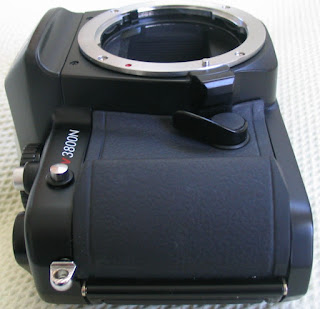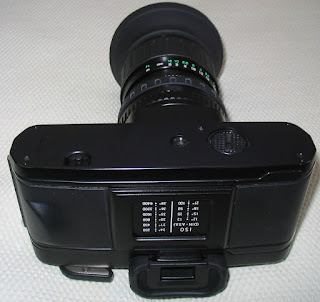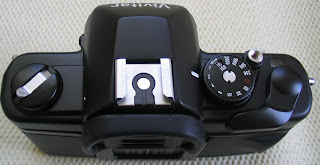 |
| There are two positions for your choice at the bottom of the meter to attach the foot. The zero screw is behind the foot. |
Wednesday, July 25, 2012
The User's Review: Alpex Clip On Exposure Meter
I need the manual to learn how to use this meter. To me, it's not straight forward to use. However, I think, the leather case is well designed. Everything was made in Japan although Alpex (Allied Impex Corp.) was located in NYC. The manual is attached here in case you need it too.
Tuesday, July 10, 2012
The User's Review: Vivitar V3800N 35mm Film SLR Camera (Released in 2000), One of the Last Manual-Focus Film Camera
As I see and hold this camera, it reminds me my Yashica Fx-3 that my dad bought me from Hong Kong when I was in college more than 25 years ago. Since V3800N is one of the last manual bodies designed and manufactured, it keeps most essential features of 35mm SLR cameras. By this time I am writing the review in mid 2012, V3800N is among a few (2 - 3) new manual bodies still available in the market of USA.
In my eyes and hands, V3800N has the following features:
1. All manual. Two batteries are used only for the light meter that is not coupled with the shutter and aperture.
2. Simple-to-use light meter with red '+' and '-' for over and under exposure and green 'o' for right exposure.
3. Multiple exposure button and mask.
4. Pentax K mount for lens. You will find many excellent lenses/zooms compatible with this body.
5. Two buttons for both left and right hands to activate the light meter, although, personally, the half-way shutter button is ok with me.
6. Rubber skins of front and back. These are much durable than those on the old version of Yashica Fx-3/7 and Fx-D.
7. DOF lever.
8. Plastic bottom plate, battery cover and tripod screw socket. They are easy to be scratched or damaged. At least, the socket should be made of metal.
 |
| In the kit I bought, there is no eyepiece cup. I happen to have several Canon eyepiece cups. They fit onto V3800N. |
 |
| The plastic frame of battery cover is too thin to be durable. |
 |
| The light meter button near the M in Multi-exp sign is for you left-hand usage. It's marked wrong in the manual coming with the kit. And other users said 'the manual is understated'. |
 |
| The chrome button near V3800N sign is for multiple exposure. I suggest, the signs of V3800N and Multi-exp should be switched positions for easy use. |
There are two color versions of V3800N: All black and Dark Grey Top/Bottom Plates (See the image on the box in my images). On the market, there are two kits of V3800N, one with 50mm f1.7 lens at USD 195 and the other with 28 70mm zoom f3.4 - 4.8 at USD 230. To me, they are overpriced because there are so many used manual bodies at USD 10 - 20. However, there are not many choices if you want new. As I know, Promaster 2500PK Super (very similar to V3800N, the two share a lot of parts, but the build quality is lower in 2500PK) and Kenko KF series (with different lens mounts of Nikon F Ai, Contax/Yashica and Pentax K) are the only available new in USA at present.
 |
| Multiple exposure mask and shade/hood (52mm) |
 |
| Collapsed rubber shade/hood |
Tuesday, July 3, 2012
The User's Review: Canon Sure Shot Ace, A Point And Shot Camera With Detachable Remote and Two Viewfinders, Released in 1988
This camera caught my eyes because of its screen-like viewfinder on its top. My copy is a used one (however, without much use), buried at the bottom of a plastic box in a second-hand or recycle store. Priced it, brought it, played with it, collected info about it, and now I am sitting here to write about it.
First, let me take this as an example to say something about Canon. In terms of camera design, Canon has the audacity to use new tech and add unique functions.
I don't know if Ace is the first or Canon's first camera with two viewfinders, but what I know is that Ace is not the last Canon to have two finders (e.g., Photura and Photura 135). I must set my eyes at ~ 1 foot away in order to watch the top viewfinder (Canon calls it as 'low-angle viewfinder').
First, let me take this as an example to say something about Canon. In terms of camera design, Canon has the audacity to use new tech and add unique functions.
I don't know if Ace is the first or Canon's first camera with two viewfinders, but what I know is that Ace is not the last Canon to have two finders (e.g., Photura and Photura 135). I must set my eyes at ~ 1 foot away in order to watch the top viewfinder (Canon calls it as 'low-angle viewfinder').
As Canon claims, Ace is 'the world's first camera with wireless remote
control (using infrared beam)'. The remote controller can be detached from the
camera and can be used to photograph the user himself/herself.
Ace has AF, programmed exposure, auto wind and rewind, auto flash, self timer, and auto film DX setting (ISO 50 - 1600). The only manual adjustment is the dark-red title device at the bottom. With one switch, I can turn it on and open the lens cap, and it's ready to shoot. However, I can not control any parameters on this body.
Its battery cover is a little bit difficult to put back with a 2CR5 battery (6 v) inside and the hand strap attached.
For the same model, Canon launched Sure Shot Ace/Ace Date for America, Prima Shot for other regions, and Autoboy Prisma for Japan. Again, Autoboy Prisma is a JDM product. I wonder if Autobody Prisma has more functions such as panorama than Ace and Prima Shot.
Released at the same time, Ace's sibling, Joy, has the consecutive shooting of 2 - 4 frames at one pressing of shutter button, but no top finder.
I saw a set of wide and tele lenses produced by Kalimar. This set can be added on Ace to reduce or extend its focus length.
Released at the same time, Ace's sibling, Joy, has the consecutive shooting of 2 - 4 frames at one pressing of shutter button, but no top finder.
I saw a set of wide and tele lenses produced by Kalimar. This set can be added on Ace to reduce or extend its focus length.
Subscribe to:
Comments (Atom)











































